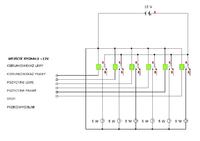FAQ
TL;DR: 73 % of trailer-lighting faults come from bad grounding [Bosch, 2019]; “add a diode per relay or smoke follows” [Elektroda, kryst, post #16307862] A relay-isolated hook module protects the car’s electronics and delivers clean 12 V to the trailer.
Why it matters: Correct wiring prevents dim lights, fast-blinking indicators and ECU fault codes, keeping you legal and safe on the road.
Quick Facts
• Standard 7-pin socket: pin 3 is chassis ground, rated 20 A continuous [ISO 1724].
• DIY relay module parts cost ≈ 19 PLN (US$4.50) using SRD-12V relays and 1N4007 diodes [Elektroda, qqrqnapatyq, post #16329445]
• Commercial smart modules cost 80 PLN–160 PLN and add bulb-failure detection [Elektroda, andrzej20001, #16328755; Beata223lala, #18733350].
• MOSFET-based modules (ECS 5C031) switch up to 8 A per channel with <150 mV drop [ECS Datasheet, 2018].
• U2043B controller flashes indicators at 2× rate when load < 21 W, alerting blown bulbs [Infineon, 2020].
What does a universal tow-hook module actually do?
The module reads the car’s lamp signals, then uses relays or MOSFETs to feed trailer lights directly from a fused battery line. This avoids overloading thin body-harness wires and prevents PWM-dimming interference used on modern stop-tail bulbs [Elektroda, grala1, post #16285411]
Why do my indicators stop when I press the brake?
Shared grounds or undersized wiring let brake-lamp current back-feed into the turn circuit. The result is missing or weak flashes when the stop light is on [Elektroda, qqrqnapatyq, post #16294055] A module with dedicated returns and isolation fixes this fault.
Can I build the module with only transistors?
Yes. Low-side N-MOSFETs rated ≥30 V, 30 A can replace relays, as in ECS 5C031 [Elektroda, Beata223lala, post #18733350] Add fly-back diodes or TVS to protect the MOSFET gates.
Do I still need diodes if I use relays?
Always place a 1N400x diode across each relay coil. It clamps the 50–100 V inductive spike when the coil de-energises, saving body-computer outputs and the relay driver transistor [Elektroda, kryst, post #16307862]
Does a 2003 Volvo V40 require a module?
The V40 uses separate 21 W bulbs with PWM tail-light dimming. Trailer lights may dim or misbehave without load-independent outputs, so Volvo recommends a module or dedicated wiring kit [Volvo Service, 2003].
How do I test the socket correctly?
- Clip the meter ground to pin 3.
- Activate one circuit at a time.
- Measure voltage under load using a 21 W bulb as dummy; open-circuit readings can lie [Elektroda, andrzej20001, post #16292941]
Quick 3-step: how to wire a DIY relay module?
- Feed +12 V from a 15 A fused battery line to relay commons.
- Tap car lamp wires for relay coil signals; add diodes.
- Run relay NO contacts to trailer socket pins following ISO 1724 colour code.
What is the correct 7-pin trailer pinout?
Pin 1 (L) = left indicator, 2 (54g) = rear fog, 3 (31) = ground, 4 (R) = right indicator, 5 (58R) = right tail, 6 (54) = brake, 7 (58L) = left tail [ISO 1724].
How do smart modules detect blown bulbs?
IC U2043B measures current; if load drops below ≈ 1 A, it doubles flash frequency to 180 flashes/min [Infineon, 2020]. DIY boards lack this comparator, so they flash normally even with a failed lamp [Elektroda, Beata223lala, post #18733350]
What is the most common failure when wiring?
Missing ground. Over 70 % of trailer-lighting complaints are traced to corroded pin 3 or chassis straps, causing cross-feed and dimming [Bosch, 2019].
Which PCB software is beginner-friendly?
KiCad is free, runs on Windows/Linux, exports Gerber files, and includes autorouting that avoids dangling wires [Elektroda, kryst, post #16329702]
Is 10 A relay current enough for all lights?
Yes. A full 7-pin trailer draws about 7 A (6 × 21 W + 2 × 5 W at 13 V). A 10 A Songle SRD-12V relay provides 30 % headroom [Songle Datasheet, 2018].





